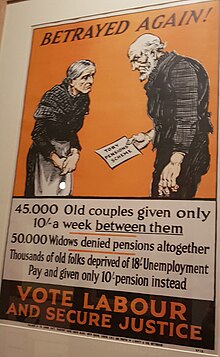State Pension (United Kingdom)
The State Pension is a United Kingdom Social Security benefit, also known as Retirement Pension. To get it people have to pay National Insurance Contributions.
Pensions were introduced for poor people over 70 in 1908. The Widows’, Orphans’ and Old Age Contributory Pensions Act in 1925 started the first state pension scheme, paid for by both the employee and employer. In 1940 the Old Age and Widows’ Pension Act improved the benefits available to women.

The Basic State Pension was introduced in 1948.
In 1978 the State Earnings-Related Pension Scheme and the Guaranteed Minimum Pensions started.
In 1995 the law was changed so that the women's pension age would be made equal with men. After 2007 the age people could claim a pension was gradually raised because people were living longer. By 2027 the State Pension age will be 67.[1] The new State Pension was introduced for people reaching State Pension Age from 6 April 2016.
In 2023/4 the full rate of New State Pension is £203.85.[2]
In February 2022 there were 12,496,000 people getting State Pension.
Since October 2020 the minimum State Pension Age has been 66 years.[3]
References
change- ↑ "2010 to 2015 government policy: State Pension simplification". GOV.UK. Retrieved 2023-01-26.
- ↑ "Benefit and pension rates 2023 to 2024". GOV.UK. Retrieved 2023-01-26.
- ↑ "DWP benefits statistics: August 2022". GOV.UK. Retrieved 2023-01-26.